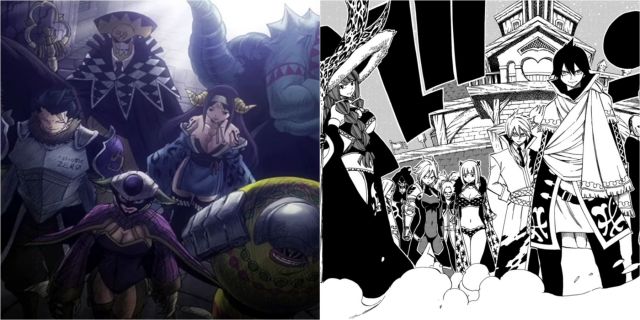Highlights
- Fairy Tail has a problem with poorly developed villains, lacking memorable backstories that would make them relatable and morally ambiguous.
- The show’s antagonists also suffer from a lack of profound motives, often resorting to causing chaos without clear reasoning behind their actions.
- The concept of redemption is overused in Fairy Tail, as many villains are easily redeemed without proper justification, diminishing the impact of this plot element.
Similar to other long-running shōnen anime, Fairy Tail boasts a prolific villainous landscape, with all sorts of antagonists sprouting up from time to time. However, it’s no secret that none of these villains are memorable or profound in any way whatsoever, with viewers failing to deduce the logic behind their irrational goals.
Featuring likable protagonists is necessary for any show, yet the narrative’s actual success rides on the antagonists’ profundity and characterization. Fairy Tail stupendously fails at delivering this element, as none of its villains are memorable in any way, nor do they play a long-term role in the series. It’s obvious that Fairy Tail’s antagonists are riddled with the effects of hasty writing and poor characterization, yet the actual issue with these characters runs much deeper.
RELATED: Shonen Anime Like Fairy Tail
Antagonists With Unexplored Backstories

Every villain has an origin story, and without properly exploring these beginnings, it’s almost impossible to create a good antagonist. A past that showcases the events that led to a character turning evil makes their journey more relatable and their character morally ambiguous, forcing viewers to shift perspectives and explore things from the antagonist’s framework.
Some of the most memorable anime villains embody this very concept, becoming almost synonymous with the series itself. Fairy Tail, on the other hand, poorly executed this aspect for its villains, giving half-baked backstories to a few and neglecting the rest entirely. The ones that received backstories were never properly explained either, and their current motives had no ties to their pasts.
Several antagonists had their pasts’ rooted in the Tower of Heaven, with antagonists such as the Oracion Seis, Ultear, and Jellal having some sort of connection to this project. While the series delved into their past of being conscripted as child slaves, it was never exactly tied to their current objectives and goals. This incoherence makes these villains seem hastily written without any depth of character, forcing viewers to overlook them entirely.
Villains Lacked Profound Motives

Every antagonist’s objective is rooted in some sort of clear motive, one that serves as a reasoning behind their villainous actions. Profound antagonists have motives that are morally gray, forcing viewers to question the nuances behind their objectives. On the other hand, villains that are downright evil without any apparent reason are difficult to relate to, in-turn becoming forgotten right after they are defeated.
Almost every single one of Fairy Tail’s antagonists suffered from this lack of profundity, with most villains not even having a clear objective other than ensuing chaos and destruction. The Balam Alliance itself is a prime example of this hasty writing, as all three guilds that comprised it lack proper reasoning. The Oracion Seis wanted to acquire Nirvana to plummet the world into chaos, yet they had no motive or reasoning behind treading such a heinous path.
RELATED: Best Manga To Read If You Love Fairy Tail
Grimoire Heart wanted to acquire Zeref’s power and rid the world of the weak, leaving behind only those with exceptional magic power. Their motive for doing so was never explored either, making Hades and the Seven Kin of Purgatory seem like nothing more than a few lunatics. Tartaros had a similar goal of ridding all magic users, though their motive lay in proving their superiority to regular mages. With such poorly explained motives, it comes as no surprise that almost all of these villains were entirely forgotten right after their respective arcs.
Redemption Without Reason

Redemption is a common theme in many anime, offering villains a chance to redeem themselves and prove their allegiances with the protagonists. However, this redemption should never come easy for villains, since redeeming every other villain takes away the novelty and profundity of this element. Moreover, villains with morally gray areas are more likely to receive redemption as viewers can understand the method to their madness. However, too many redemptions can make this concept seem more of a plot device, taking away the actual nuances behind this act.
Fairy Tail fell into this very trap, as the show redeemed most of its villains on the basis of nothing more than merely being defeated in battle. Most of Fairy Tail’s villains are out to spread chaos throughout Fiore and propagate Zeref’s beliefs. Their objectives don’t offer a sliver of moral ambiguity, presenting themselves as nothing but pure evil. However, the show keeps on redeeming its villains, reducing the significance of the redemption itself.
Jellal’s redemption is the only one that was properly executed since he had spent years under the Magic Council’s imprisonment, and he had thoroughly reflected on his past misdeeds. However, antagonists such as Sabertooth, Ultear, Meredy, and Ajeel Raml were redeemed almost immediately, making their past misdeeds seem almost entirely irrelevant. Hiro Mashima failed to write captivating villains for the series, and this poorly done aspect of Fairy Tail is reflected in the show’s fading popularity within the anime landscape.
Fairy Tail is available to stream on Prime Video.











Leave a Reply